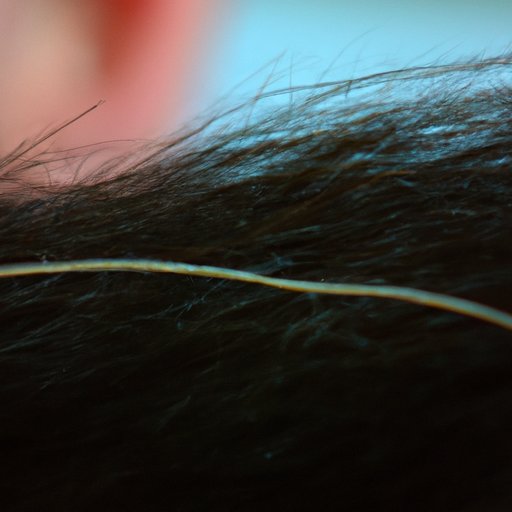Introduction
Hair follicles are tiny structures located in the dermis layer of the skin. They are responsible for producing hair and play an important role in hair growth. In this article, we will explore what a hair follicle is, how it works, and how to keep it healthy.
Exploring the Anatomy of a Hair Follicle
A hair follicle is made up of several parts including the bulb, sebaceous gland, arrector pili muscle, and a sheath. The bulb is the base of the follicle and is where the hair shaft grows from. The sebaceous gland is a small gland that produces oil to lubricate the hair and skin. The arrector pili muscle is a small muscle that is responsible for causing the hair to stand on end when stimulated. The sheath is a layer of cells that wraps around the hair shaft and helps to protect it.
How Hair Grows from a Hair Follicle
Hair growth begins in the follicle. This is where new cells are produced and the hair shaft is formed. As the new cells push up through the follicle, they form the hair shaft which eventually emerges from the scalp. This process is known as anagen, or active growth phase. As the hair continues to grow, the follicle enters the catagen, or resting phase. During this phase, the hair stops growing and the follicle shrinks. Finally, the telogen, or shedding phase occurs and the old hair is shed from the scalp.

The Role of Hair Follicles in Hair Growth
Hair follicles are essential for hair growth. Without them, it would be impossible for hair to grow. The follicle is responsible for creating the hair shaft and providing it with nutrients. It also plays an important role in regulating the growth cycle of the hair. Hormones can also affect the growth of the hair by influencing the activity of the follicles.

Investigating Hair Follicles: What They Are and How They Work
To understand how hair follicles work, it is important to know what they are. A hair follicle is a small structure located in the dermis layer of the skin. It consists of several parts including the bulb, sebaceous gland, arrector pili muscle, and a sheath. The bulb is the base of the follicle and is where the hair shaft grows from. The sebaceous gland produces oil to lubricate the hair and skin. The arrector pili muscle is a small muscle that causes the hair to stand on end when stimulated. The sheath is a layer of cells that wraps around the hair shaft and helps to protect it.
Hair Follicles: An Overview
There are two types of hair follicles: vellus and terminal. Vellus follicles are smaller and produce fine, light-colored hairs. Terminal follicles are larger and produce thicker, darker hairs. Common issues with hair follicles include alopecia, which is a condition where the hair follicles shrink and stop producing hair, and trichotillomania, which is a compulsive disorder where people pull out their own hair.
Hair Follicles: A Closer Look at their Function
Hair follicles play an important role in hair production. They are responsible for producing the hair shaft and providing it with nutrients. The follicles also regulate the growth cycle of the hair. Different hormones can influence the activity of the follicles and affect the growth of the hair.

How Hair Follicles Work to Produce Hair
Hair follicles produce hair through a process called keratinization. This process involves the production of keratin proteins in the follicle which then form the hair shaft. Factors that can affect the health of the hair follicle include genetics, hormones, age, and lifestyle factors such as stress and diet.
Conclusion
Hair follicles are essential for hair growth, as they are responsible for producing the hair shaft and providing it with nutrients. Different hormones can influence the activity of the follicles and affect the growth of the hair. To keep hair follicles healthy, it is important to maintain a healthy lifestyle, manage stress levels, and eat a balanced diet.


